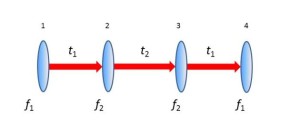“Any sufficiently advanced technology is indistinguishable from magic.”
-Arthur C. Clarke

Doctoral student Joseph Choi is pictured with a a multidirectional `perfect paraxial’ cloak using 4 lenses.
Credit: University of Rochester Newscenter
Scientists at the University of Rochester have developed a real-world invisibility cloak. This Harry Potter-esque cloak has the ability to hide objects from view, and is surprisingly inexpensive due to the readily available materials in its novel configuration.
“There’ve been many high tech approaches to cloaking and the basic idea behind these is to take light and have it pass around something as if it isn’t there, often using high-tech or exotic materials,” said John Howell, a professor of physics at the University of Rochester.
The Rochester Cloak is different from its predecessors, because unlike invisibility cloaks of the past, this cloak maintains an object’s invisibility even when the viewer changes his or her angle and creates a different viewpoint.
“This is the first device that we know of that can do three-dimensional, continuously multidirectional cloaking, which works for transmitting rays in the visible spectrum,” said Joseph Choi, a PhD student at Rochester’s Institute of Optics who is working with physics professor John Howell at the university.
This from the University of Rochester Newscenter:
In order to both cloak an object and leave the background undisturbed, the researchers determined the lens type and power needed, as well as the precise distance to separate the four lenses. To test their device, they placed the cloaked object in front of a grid background. As they looked through the lenses and changed their viewing angle by moving from side to side, the grid shifted accordingly as if the cloaking device was not there. There was no discontinuity in the grid lines behind the cloaked object, compared to the background, and the grid sizes (magnification) matched.
In its simplest form, the device functions by arranging four lenses in a placement that when you look through them, you can clearly see what is beyond the farthest lenses – but not what is placed between the two middle lenses.
The guys at the University of Rochester have even provided a step-by-step guide of how to make one for yourself.

For their demonstration cloak, the researchers used 50mm achromatic doublets with focal lengths f1 = 200mm and f2 = 75mm.
1. Purchase 2 sets of 2 lenses with different focal lengths f1 and f2 (4 lenses total, 2 with f1 focal length, and 2 with f2 focal length).
2. Separate the first 2 lenses by the sum of their focal lengths (So f1 lens is the first lens, f2 is the 2nd lens, and they are separated by t1= f1+ f2).
3. Do the same in Step 2 for the other two lenses.
4. Separate the two sets by t2=2 f2 (f1+ f2) / (f1– f2) apart, so that the two f2 lenses are t2 apart.
Want to learn more about what is in store for the future of invisibility cloaks? Head over to ECS’s Digital Library and see our scientists’ innovative research on the topic.

